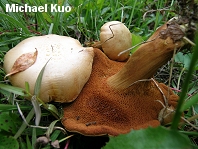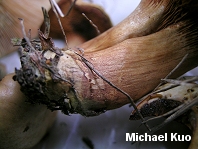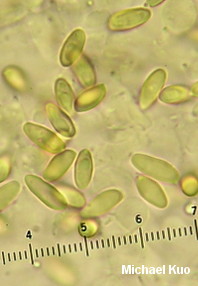| Major Groups > Boletes > Red-Pored Boletes > Chalciporus piperatus |

|
Chalciporus piperatus [ Basidiomycota > Boletales > Boletaceae > Chalciporus . . . ] by Michael Kuo This drab little bolete has several features that combine to make it fairly easy to identify: dull reddish brown to pinkish tan colors; a brownish-reddish pore surface that bruises darker brown but not blue; bright to dull yellow basal mycelium on the stem; and a very peppery taste. It is almost always found under conifers, and is fairly widely distributed in North America. Several lesser-known species of Chalciporus are similar in appearance but lack the bitter taste; see the key to red-pored boletes for help separating them. Chalciporus piperatoides is virtually identical but bruises blue. Boletus piperatus and Suillus piperatus are synonyms. Description: Ecology: Mycorrhizal--primarily with conifers, but well documented under aspen and other hardwoods (Singer, 1986); growing alone, scattered, or gregariously; summer and fall; fairly widely distributed, but more common in northern and western North America. Cap: 2-7 cm; convex, becoming broadly convex; sticky when fresh, but soon dry; bald; shiny; dull reddish brown to dull pinkish tan, fading to tan. Pore Surface: Beginning to run down the stem; cinnamon brown to reddish brown, becoming dull coppery reddish at maturity; bruising dark rusty brown; usually with 1-2 pores per mm near the margin, but often with wide, angular pores near the stem that create fine lines at the stem apex; tubes to 5 mm deep. Stem: 2-5 cm long; 1-2 cm thick; more or less equal; dry; solid; colored like the cap; bald; base with bright to dull yellow mycelium. Flesh: Yellowish to pinkish in the cap; brighter yellow in the stem; not staining on exposure, or staining slightly pinkish. Odor and Taste: Odor not distinctive; taste strongly peppery. Chemical Reactions: Ammonia grayish to olive on cap surface; negative to pinkish gray on flesh. KOH negative to gray on cap surface; negative to gray on flesh. Iron salts negative on cap surface; negative on flesh. Spore Print: Brown to reddish brown. Microscopic Features: Spores 7-11 x 3-4 µ; smooth; subfusoid; yellowish in KOH. Hymenial cystidia fusoid to fusoid-ventricose; to about 50 x 10 µ. Pileipellis a tangled layer of cylindric elements 5-12 µ wide; terminal elements with rounded to subacute apices; hyaline to yellowish. REFERENCES: (Bulliard, 1790) Bataille, 1908. (Fries, 1821; Saccardo, 1888; Coker & Beers, 1943; Snell & Dick, 1970; Smith & Thiers, 1971; Thiers, 1975; Grund & Harrison, 1976; Smith, Smith & Weber, 1981; Arora, 1986; Singer, 1986; Phillips, 1991/2005; Lincoff, 1992; Both, 1993; Evenson, 1997; Barron, 1999; Bessette, Roody & Bessette, 2000; McNeil, 2006; Miller & Miller, 2006; Trudell & Ammirati, 2009.) Herb. Kuo 08140703, 08170802. This site contains no information about the edibility or toxicity of mushrooms. |
© MushroomExpert.Com |
|
Cite this page as: Kuo, M. (2013, December). Chalciporus piperatus. Retrieved from the MushroomExpert.Com Web site: http://www.mushroomexpert.com/chalciporus_piperatus.html |


